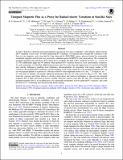Files in this item
Unsigned magnetic flux as a proxy for radial-velocity variations in sun-like stars
Item metadata
| dc.contributor.author | Haywood, R. D. | |
| dc.contributor.author | Milbourne, T. W. | |
| dc.contributor.author | Saar, S. H. | |
| dc.contributor.author | Mortier, A. | |
| dc.contributor.author | Phillips, D. | |
| dc.contributor.author | Charbonneau, D. | |
| dc.contributor.author | Cameron, A. Collier | |
| dc.contributor.author | Cegla, H. M. | |
| dc.contributor.author | Meunier, N. | |
| dc.contributor.author | III, M. L. Palumbo | |
| dc.date.accessioned | 2022-08-25T11:30:37Z | |
| dc.date.available | 2022-08-25T11:30:37Z | |
| dc.date.issued | 2022-08-10 | |
| dc.identifier | 280849641 | |
| dc.identifier | 575ba676-08b4-4739-868a-526d940553ff | |
| dc.identifier | 85135988681 | |
| dc.identifier | 000837396900001 | |
| dc.identifier.citation | Haywood , R D , Milbourne , T W , Saar , S H , Mortier , A , Phillips , D , Charbonneau , D , Cameron , A C , Cegla , H M , Meunier , N & III , M L P 2022 , ' Unsigned magnetic flux as a proxy for radial-velocity variations in sun-like stars ' , Astrophysical Journal , vol. 935 , no. 1 , 6 . https://doi.org/10.3847/1538-4357/ac7c12 | en |
| dc.identifier.issn | 0004-637X | |
| dc.identifier.other | Jisc: 513174 | |
| dc.identifier.other | publisher-id: apjac7c12 | |
| dc.identifier.other | manuscript: ac7c12 | |
| dc.identifier.other | other: aas24808 | |
| dc.identifier.other | ORCID: /0000-0002-8863-7828/work/117211243 | |
| dc.identifier.uri | https://hdl.handle.net/10023/25889 | |
| dc.description | Funding: A.C.C. acknowledges support from the Science and Technology Facilities Council (STFC) consolidated grant number ST/R000824/1. | en |
| dc.description.abstract | A major obstacle to detecting and characterizing long-period, low-mass exoplanets is the intrinsic radial-velocity (RV) variability of host stars. To better understand RV variability, we estimate disk-averaged RV variations of the Sun over its magnetic cycle, from the Fe i line observed by SDO/HMI, using a physical model for rotationally modulated magnetic activity that was previously validated against HARPS-N solar observations. We estimate the unsigned magnetic flux and show that a linear fit to it reduces the rms of RV variations by 62%, i.e., a factor of 2.6. We additionally apply the FF′ method, which predicts RV variations based on a star’s photometric variations. At cycle maximum, we find that additional processes must be at play beyond suppression of convective blueshift and velocity imbalances resulting from brightness inhomogeneities, in agreement with recent studies of RV variations. By modeling RV variations over the magnetic cycle using a linear fit to the unsigned magnetic flux, we recover injected planets at a period of ≈300 days with RV semi-amplitudes down to 0.3 m s−1. To reach 0.1 m s−1, we will need to identify and model additional phenomena that are not well traced by ∣Bˆobs∣ or FF′. This study motivates ongoing and future efforts to develop observation and analysis techniques to measure the unsigned magnetic flux at high precision in slowly rotating, relatively inactive stars like the Sun. We conclude that the unsigned magnetic flux is an excellent proxy for rotationally modulated, activity-induced RV variations, and could become key to confirming and characterizing Earth analogs. | |
| dc.format.extent | 41298158 | |
| dc.language.iso | eng | |
| dc.relation.ispartof | Astrophysical Journal | en |
| dc.subject | Solar cycle | en |
| dc.subject | Active sun | en |
| dc.subject | Quiet sun | en |
| dc.subject | Sunspots | en |
| dc.subject | Solar faculae | en |
| dc.subject | Exoplanet detection methods | en |
| dc.subject | Radial velocity | en |
| dc.subject | Astronomy data analysis | en |
| dc.subject | QB Astronomy | en |
| dc.subject | QC Physics | en |
| dc.subject | 3rd-DAS | en |
| dc.subject.lcc | QB | en |
| dc.subject.lcc | QC | en |
| dc.title | Unsigned magnetic flux as a proxy for radial-velocity variations in sun-like stars | en |
| dc.type | Journal article | en |
| dc.contributor.sponsor | Science & Technology Facilities Council | en |
| dc.contributor.institution | University of St Andrews. School of Physics and Astronomy | en |
| dc.contributor.institution | University of St Andrews. St Andrews Centre for Exoplanet Science | en |
| dc.identifier.doi | 10.3847/1538-4357/ac7c12 | |
| dc.description.status | Peer reviewed | en |
| dc.identifier.grantnumber | ST/R00824/1 | en |
This item appears in the following Collection(s)
Items in the St Andrews Research Repository are protected by copyright, with all rights reserved, unless otherwise indicated.

